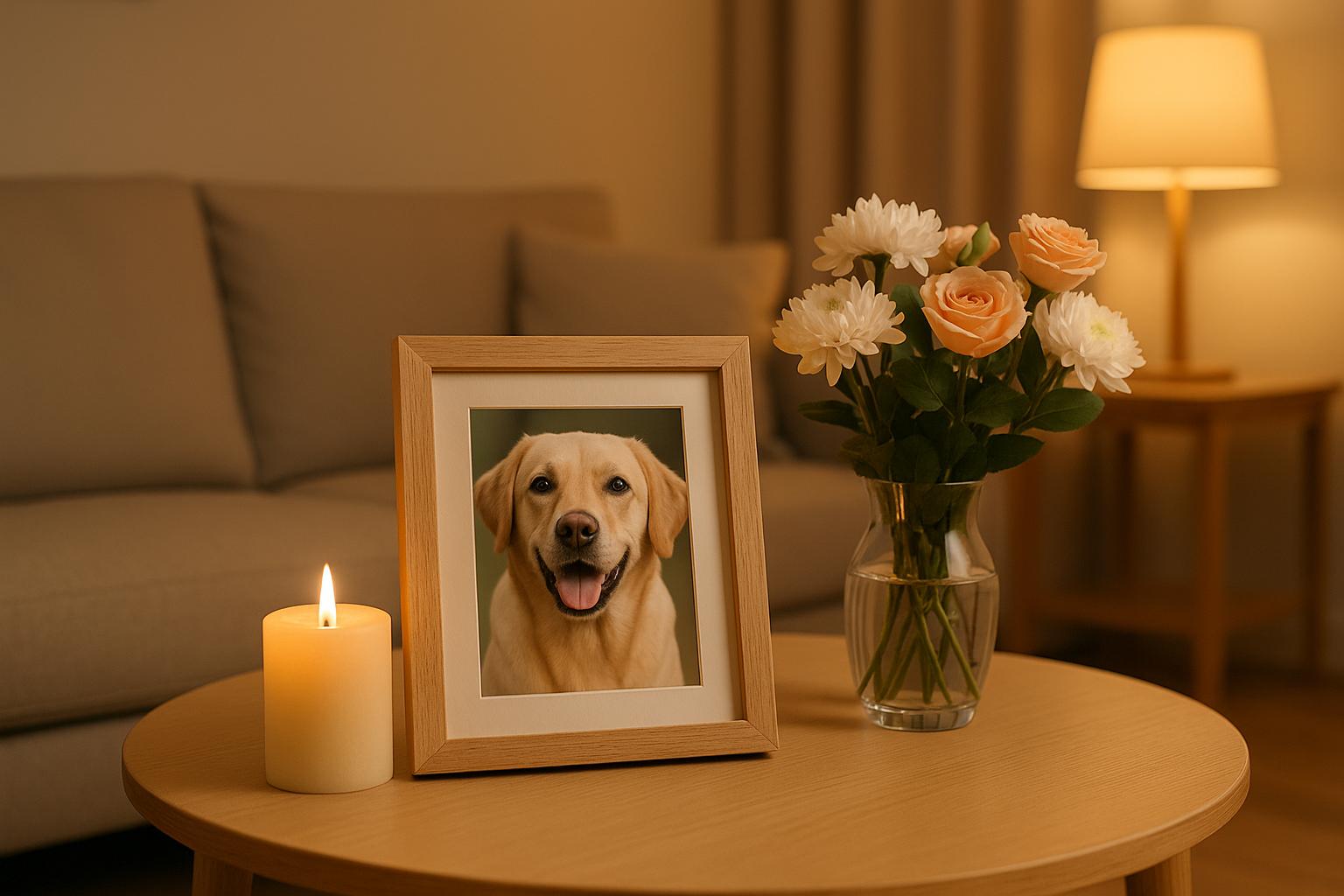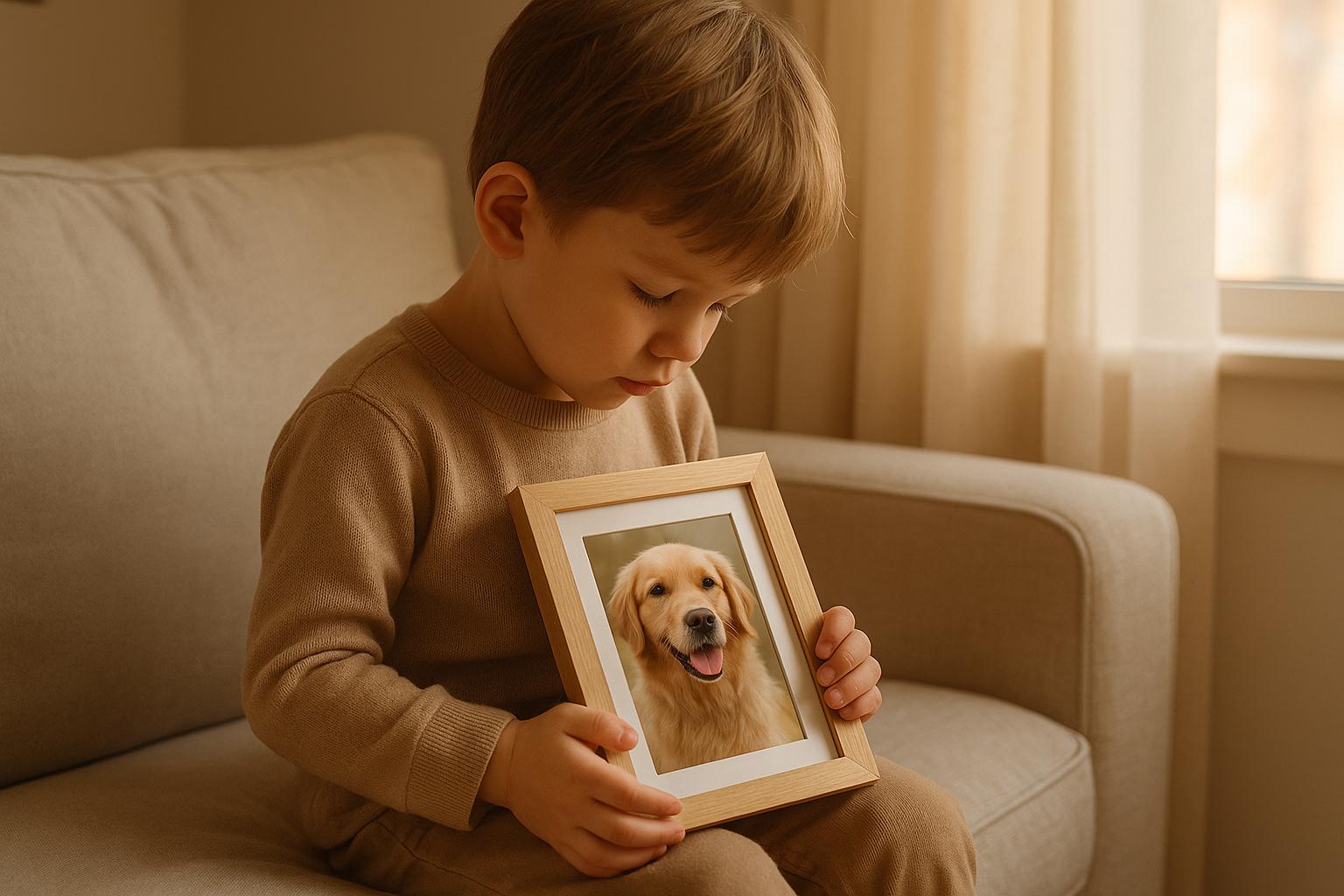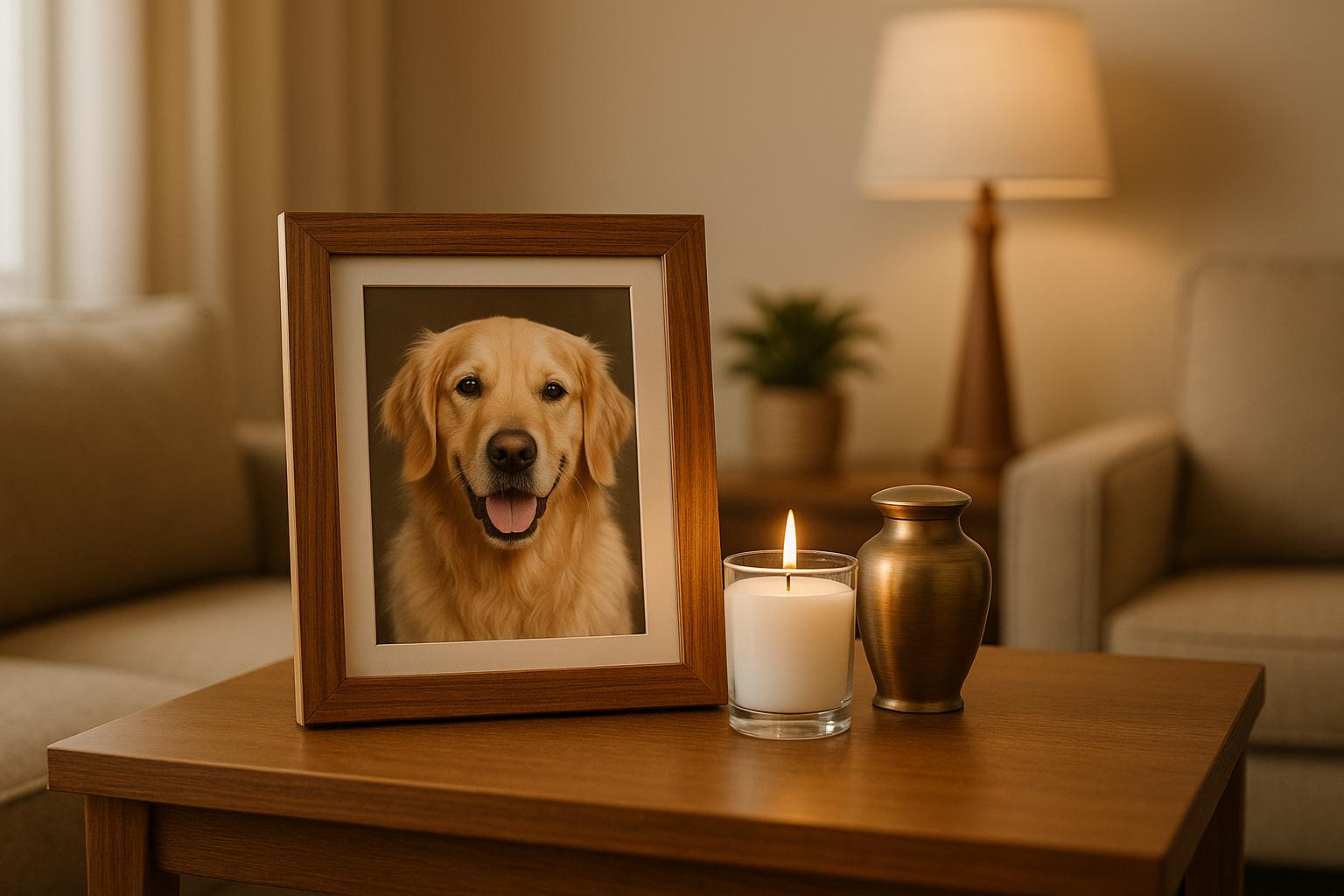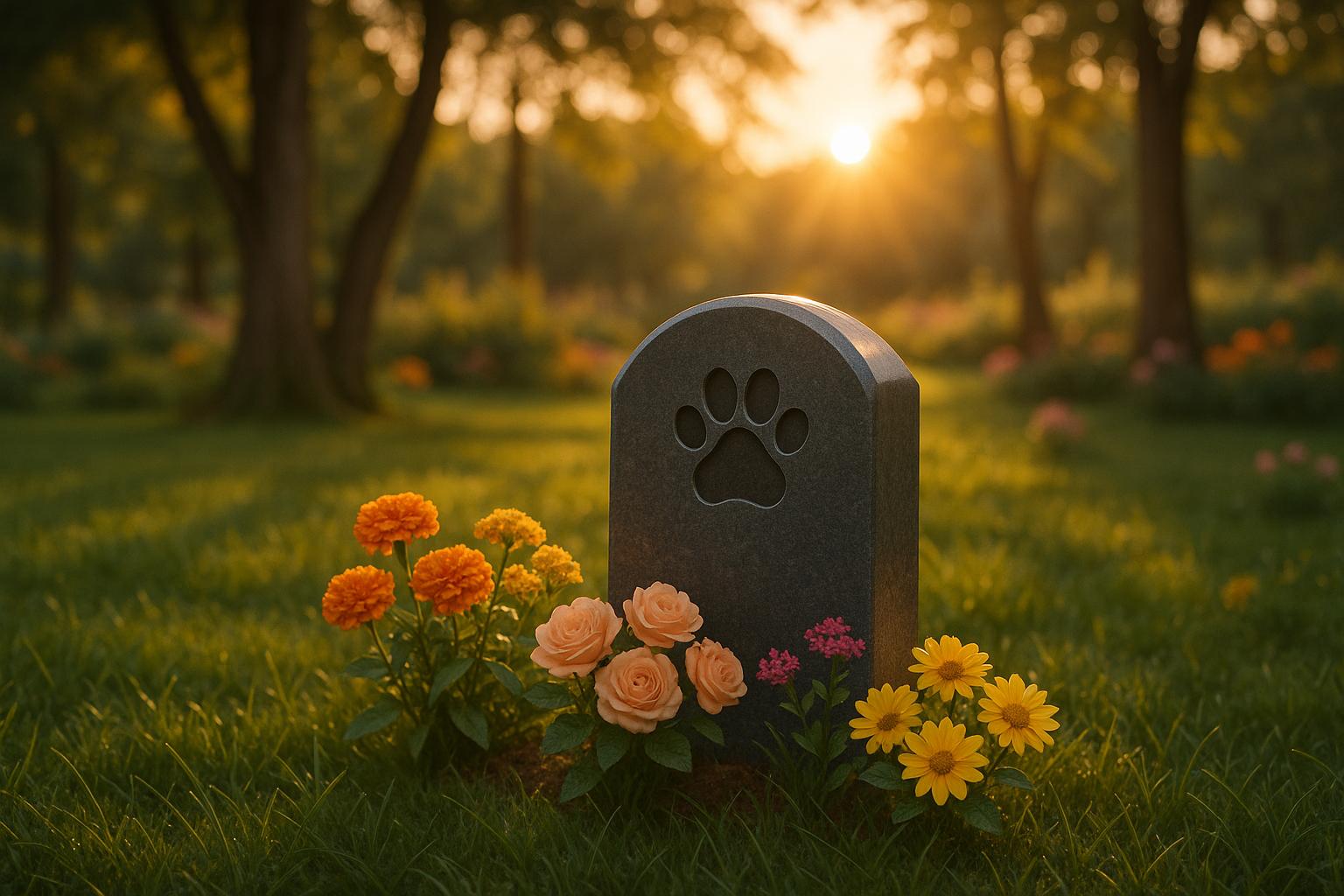Losing a pet suddenly can be overwhelming, both emotionally and practically. Here's what you should do:
- Confirm their passing: Check for breathing, heartbeat, and responsiveness. If unsure, contact a vet immediately.
- Handle the body safely: Use gloves, clean the body, and position them respectfully. Keep the remains cool using refrigeration or ice.
- Notify loved ones: Share the news gently, especially with children, using age-appropriate language.
- Contact professionals: Call your vet to discuss next steps, including necropsy or aftercare options like cremation or burial.
- Seek emotional support: Grieve in your own way, join support groups, or consult pet loss counselors.
- Honor their memory: Consider memorials like urns, keepsakes, or donations in their name.
Take your time to grieve and make decisions that feel right for you. Support is available to help you through this difficult moment.
How I Dealt with Death of My Dog, Grieving when your dog dies Unexpectedly? Dealing w Pet Loss
Confirming Death and Checking the Situation
Discovering your pet unresponsive can be a deeply emotional moment. While it’s natural to feel overwhelmed, taking a few moments to assess the situation carefully can help you determine whether your pet has passed away or if there’s still time to act.
How to Check for Signs of Life
Begin by closely observing your pet. Look for any chest movement that might indicate breathing. Watch carefully for 30–60 seconds, as shallow breathing can be subtle.
Next, check for a heartbeat. Place your ear near your pet’s chest or feel for a pulse on the hind leg or neck. In smaller animals like cats and small dogs, heartbeats can be rapid, so listen attentively for several seconds.
Examine their gums and responsiveness. Gently touch their eyelid or lift their lip to check gum color. Healthy pets typically have pink or red gums, while pale or grayish gums can signal death.
Try calling your pet’s name or making a familiar noise they usually respond to. You can also lightly touch their paw or ear to see if there’s any reaction. Sometimes, pets may be unconscious rather than deceased, and these simple checks can help you tell the difference.
If you’re unsure about what you observe, contact your veterinarian or an emergency animal clinic immediately. Many clinics offer 24-hour phone support and can guide you through further steps or advise you to bring your pet in for evaluation. If your pet is alive but in distress, acting quickly is essential.
Once you’ve confirmed your pet has passed, it’s time to secure the area and begin planning the next steps.
Staying Safe and Planning Next Steps
After confirming your pet’s passing, taking a few immediate actions can help you manage the situation safely and begin to navigate your grief.
If the cause of death is unclear, consider wearing gloves when handling your pet’s body to minimize any potential health risks.
Create a calm environment by gently removing other pets from the area, especially if they appear anxious or confused by what has happened.
Take a moment to reflect on the location where your pet passed away. If it’s a meaningful spot, you might want to document it before moving forward.
Think about who needs to be informed and how to approach the conversation. If children are involved, plan to share the news with sensitivity, keeping their age and emotional needs in mind. Family members may also want an opportunity to say goodbye before you make arrangements for your pet’s remains.
Assess your own emotional state and that of those around you. If someone seems to be in shock or struggling to cope, reach out to a trusted friend or family member for support. They can help with practical tasks during this difficult time.
Finally, gather the necessary information for next steps. This might include your veterinarian’s contact details, your pet’s medical records (if relevant), and any plans you’ve previously discussed for aftercare. Having these details ready can make the process smoother during a challenging moment.
Calling Veterinary and Aftercare Professionals
Once you’ve confirmed your pet’s passing, it’s time to reach out to professionals who can assist with both practical arrangements and emotional support.
When to Call Your Veterinarian
Even if your pet passed away at home, it’s important to contact your veterinarian promptly. Let them know what happened and ask about the next steps. They may suggest a necropsy (an animal autopsy) to determine the cause of death. This can be especially useful if your pet was young, appeared healthy, or if you have other animals at home who might be affected. A necropsy not only provides valuable health insights for your remaining pets but can also offer you some peace of mind.
If your pet was managing any chronic health issues or taking medications, be sure to share this information with your veterinarian. It might help them offer tailored advice or recommendations for your specific situation.
Veterinary clinics can also connect you with grief counseling resources and help coordinate aftercare services. They understand how deeply pets are woven into our lives and can guide you toward support groups or counselors who specialize in pet loss. With their assistance, you can move forward with arrangements for your pet’s remains in a way that feels respectful and comforting.
Finding Caring Aftercare Services
When you feel ready to make decisions about your pet’s remains, aftercare professionals can walk you through the available options. As the EverLoved® Team reminds us, "If your pet has just passed, you do not have to rush. Grief has its own clock".
Animal Aftercare offers 24/7 nationwide support, specifically designed to assist pet owners during these difficult times. Their team is available around the clock to address immediate concerns and help you explore various aftercare options, such as cremation or aquamation. Before contacting them, it can be helpful to have basic details about your pet on hand.
Take some time to consider your budget and how you’d like to honor your pet’s memory. Costs can vary widely depending on the type of aftercare and memorial you choose. Options range from simple urns to personalized keepsakes, like paw print or cremation jewelry.
Animal Aftercare prioritizes empathy, dignity, and respect throughout the entire process. They ensure the safe handling of your pet’s remains through a secure tagging system and will guide you through the available choices, helping you select what feels right for your family and your pet’s legacy.
A trustworthy aftercare provider will support you without making you feel rushed or pressured. Don’t hesitate to ask questions or voice any concerns about the process. A compassionate service should honor your emotional needs and personal beliefs, allowing you to make decisions that bring comfort and closure.
Handling and Storing Your Pet's Remains
When the time comes to care for your pet's remains, treating them with respect can bring some comfort to you and your family. Taking a few practical steps can help preserve their body while you await aftercare services.
Cleaning and Positioning the Body
Start by gently cleaning your pet's body with a soft, damp cloth. This can remove any discharge from the nose, mouth, or other areas, helping to maintain their natural appearance. This small act can make the experience less upsetting, especially for children.
Next, position your pet in a peaceful way, such as curling them on a favorite blanket or bed. If their eyes are open, you can gently close them by applying light pressure to the eyelids. Do the same for their mouth if needed.
When moving your pet, handle the body carefully. Rigor mortis, the stiffening of the body after death, typically begins within 2-4 hours. It's best to position your pet before this process sets in, as it becomes much harder to adjust their posture afterward.
Once your pet is positioned, the next step is to focus on keeping their remains cool.
Keeping the Remains Cool
Cooling your pet's body is essential to slow down decomposition. Here’s how you can do it:
- For smaller pets: If your pet is small enough, place them in a refrigerator set between 35-40°F. Wrap the body in a clean blanket or towel first, and then place it in a large plastic bag or container. Be sure to let other household members know about this arrangement to avoid any surprises.
- For larger pets: If refrigeration isn’t an option, you can use ice. Place your pet in a large container, kiddie pool, or even a bathtub. Surround the body with bags of ice or frozen gel packs and cover everything with blankets to help insulate the cold. Replace the ice as it melts to maintain the temperature.
- Using dry ice: Dry ice is another solution for larger pets. Always handle it with insulated gloves and ensure the area is well-ventilated. Place the dry ice in containers around your pet’s body, but avoid direct contact with the remains.
No matter the method, keep the temperature below 40°F. In warmer climates or during the summer, you may need to check and replace the ice more frequently to maintain proper cooling.
Most aftercare services, such as Animal Aftercare's 24/7 pickup, can typically collect your pet’s remains within 24-48 hours. By keeping their body cool during this time, you ensure their remains are treated with dignity while giving yourself the space to make thoughtful aftercare decisions.
sbb-itb-a4e988d
Sharing the News and Getting Emotional Help
After addressing the immediate practicalities, the next step is figuring out how to share the news of your pet’s passing. Losing a pet suddenly impacts everyone who loved them, and while you’re coping with your own grief, you’ll also need to help others process their feelings and find the support they need during this tough time.
Telling Family Members and Children
Breaking the news to your family requires care and thoughtfulness. Choose a quiet, distraction-free space where everyone can gather without interruptions from phones or TVs.
When speaking with adults and teenagers, it’s important to be honest yet gentle. Use clear, straightforward language, like “Buddy died today,” instead of euphemisms that might confuse or mislead. Allow them time to absorb the news and ask questions. Some might want to say goodbye to your pet in person, while others may prefer to hold onto their memories from a distance.
Children need age-appropriate explanations. For kids under 5, keep it simple: “Max’s body stopped working, and he died. He can’t come back, but we’ll always remember how much we loved him.” Avoid phrases like “put to sleep” or “went away,” which can create unnecessary fears about sleeping or traveling.
Older children can handle more detailed discussions about death. They might ask practical questions, like what happens to the body or whether the pet felt pain. Be truthful, but keep your answers suitable for their age. And if you don’t know the answer to a question, it’s okay to admit it.
Let everyone grieve in their own way. Reactions will vary - some might cry immediately, others may seem unaffected at first, and some could express anger. These are all normal responses. Avoid pressuring anyone to feel or act a certain way. One child might find solace in drawing pictures of your pet, while another might need time alone to process their emotions.
Encourage your family to share favorite memories, look through photos, or simply sit together quietly. Some families find comfort in holding a small memorial, giving everyone a chance to say something special about their pet.
Once the initial conversations have taken place, it’s time to focus on emotional support.
Getting Emotional Support
Caring for your emotional well-being is just as important as handling the practical aspects of loss. Grief over a pet is real grief, and it deserves acknowledgment and respect. Don’t let dismissive comments undermine your feelings - your loss is valid.
Reach out to understanding friends, professionals, or groups that specialize in pet loss. Many therapists offer counseling specifically for this type of grief, and organizations like the Association for Pet Loss and Bereavement can connect you with resources and qualified counselors across the country.
Pet loss support groups can also be a tremendous source of comfort. These groups, often hosted by veterinary schools or animal hospitals, provide a space to connect with others who truly understand what you’re going through. Online communities, like the Rainbow Bridge support forums, are available 24/7, offering a place to share your story and receive encouragement from people who’ve been in your shoes.
Grief doesn’t follow a timeline. It can ebb and flow - one day you might feel okay, only to be overwhelmed by sadness the next. Be patient with yourself and others as you navigate these emotions.
Take care of your physical health during this time. Eat regular meals, get some fresh air, and don’t hesitate to ask for help with everyday tasks. Physical activities like walking or gardening can be soothing for some, while others might find comfort in quieter pursuits like reading or listening to music.
Build a support network to help you through the healing process. This might include a close friend you can call during tough moments, a counselor for ongoing guidance, or an online community where you can share updates about your journey.
Seeking help isn’t a sign of weakness - it’s a way to honor the bond you shared with your pet. Taking the time to grieve properly is an important step in healing and cherishing the love they brought into your life.
Choosing Aftercare and Memorial Options
After navigating the initial stages of loss and grief, the next step is deciding how to honor your pet’s memory. These decisions are deeply personal, and there’s no "right" or "wrong" way to say goodbye. What matters most is choosing something that feels meaningful to you and your family.
Picking Between Cremation and Burial
Cremation is a common choice, offering flexibility to suit different needs and budgets. Typically, you can choose between individual cremation or communal cremation.
With individual cremation, your pet is cremated alone, ensuring that only their ashes are returned to you. This option allows you to keep their ashes in a special urn, scatter them in a cherished location, or even create keepsakes like memorial jewelry. Communal cremation, on the other hand, involves multiple pets being cremated together. While no ashes are returned, it provides a respectful and budget-friendly option for families who prefer not to keep physical remains.
If cremation feels right for you, look for a service with a transparent process. For example, Animal Aftercare uses a secure tagging system to ensure identity preservation and offers 24/7 nationwide service - a reassuring feature during a difficult time.
For those considering burial, home burial is an option, though it’s important to check local and state regulations about pet burial on private property. Alternatively, pet cemetery burial offers a permanent resting place with professional upkeep. Compare the costs of these options to find one that aligns with your preferences and budget.
Once you’ve decided on an aftercare method, you can explore ways to create a meaningful memorial.
Creating a Memorial for Your Pet
Memorials serve as a lasting tribute to your pet’s unique life and the bond you shared. The key is finding something that feels personal and comforting.
- Urns and keepsake containers: These provide a way to display your pet’s ashes. Options range from simple designs to custom-engraved pieces.
- Memorial jewelry: Keep a part of your pet close with pendants, rings, or bracelets. Many pieces can be personalized with your pet’s name or important dates.
- Photo memorials: Celebrate your pet’s spirit with a photo book, a custom portrait, or a favorite image printed on canvas. Digital photo frames can also cycle through cherished images, keeping your pet’s memory present in your daily life.
- Garden memorials: Planting a tree or creating a flower garden can serve as a living tribute. Adding a personalized stone marker or plaque makes it even more meaningful.
- Paw print keepsakes: A clay impression of your pet’s paw creates a tangible, lasting memento of their presence.
- Donation memorials: Honor your pet by donating to a local animal shelter, rescue organization, or veterinary school in their name. It’s a heartfelt way to give back and help other animals in need.
- Custom memorial services: Whether it’s a small gathering with loved ones or a quiet ceremony, reflecting on shared memories can be a healing experience.
Animal Aftercare also offers personalized memorial options as part of their services. Their team understands how unique every pet is and works closely with families to create tributes that truly reflect the special bond shared with their beloved companion.
Conclusion: Moving Forward with Care
Losing a pet unexpectedly is a deeply emotional experience, and having a plan can help you navigate the grief with grace. These steps provide guidance to honor your pet and process their loss.
Grief doesn’t follow a schedule. Some days may feel unbearable, while others bring small moments of comfort. Allow yourself to grieve in your own way and at your own pace - this is a reflection of the unique bond you shared with your pet.
The decisions you make during this time - whether it’s choosing a private cremation to keep their ashes nearby or creating a garden memorial to celebrate their life - are more than just ways to say goodbye. They are meaningful acts that honor the love and joy your pet brought into your life. These choices can become a vital part of your healing process, helping you find a way to move forward while keeping their memory alive.
Seeking support is an act of courage, not weakness. Whether it’s leaning on family, joining a pet loss support group, or turning to compassionate professionals like Animal Aftercare, you don’t have to face this alone. Animal Aftercare’s 24/7 support ensures that help is always available, offering understanding and respect for both you and your pet during this difficult time.
Creating a memorial is the beginning of your journey toward healing. Moving forward doesn’t mean forgetting or "getting over" the loss - it’s about carrying their memory with you. The memorials you create, the stories you share, and the love you hold onto are all ways your pet’s spirit continues to live on.
Take it one day at a time. Be gentle with yourself, and trust that while the pain may not completely fade, it will soften into a bittersweet reminder of the unbreakable bond you shared with your beloved pet.
FAQs
How can I tell if my pet has passed away or is unconscious?
If you're unsure whether your pet has passed away or is unconscious, start by checking for any signs of life. Watch their chest closely for movement or feel for airflow near their nose. You can also gently place your hand on their chest, just behind the front leg, to check for a heartbeat.
If you don't notice any signs or still feel uncertain, reach out to your veterinarian right away. They can guide you on what to do next and determine if emergency care is necessary. Quick action in these situations can be incredibly important.
How can I support my children after the sudden loss of a pet?
When a pet passes away unexpectedly, it’s crucial to help children navigate their emotions in a way that aligns with their age and level of understanding. Use clear, simple language to explain what happened - honesty is key, but approach the conversation with gentleness. Let them know it’s okay to feel sad, confused, or even angry, and encourage them to express those feelings openly.
For younger children, tools like books or stories can make the concept of loss easier to grasp. Reassure them that what they’re feeling is completely normal and remind them that you’re there to support them through it all. Give them the space to grieve in a way that feels natural to them. This might mean drawing pictures, sharing happy memories of the pet, or even creating a small memorial to honor their furry friend. Above all, be patient and provide comfort as they work through this challenging time.
How should I care for my pet’s remains until aftercare services are available?
If your pet has passed unexpectedly and you're waiting for aftercare services, it's crucial to store their remains carefully to slow decomposition. The most effective method is refrigeration. Place your pet's body in a leak-proof container or securely double-wrap it in plastic bags, then store it in a refrigerator or freezer. This helps preserve the remains by slowing the natural process.
If refrigeration isn't an option, try to keep your pet in the coolest area of your home, such as a basement or garage. Make sure the body is wrapped securely to maintain cleanliness and dignity. Handle your pet gently and with care during this emotional time. Reach out to aftercare services promptly to make arrangements for the next steps.







